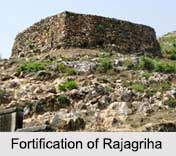 Fortification of Rajagriha which is now called Rajgir gives the detailed information on the architecture of the royal abode of early Indian royal kingdom. It is the holy site of Pavapuri which is believed to be the place of great end of the twenty-fourth Tirthankara "Mahavira" by the Jain devotees.
Fortification of Rajagriha which is now called Rajgir gives the detailed information on the architecture of the royal abode of early Indian royal kingdom. It is the holy site of Pavapuri which is believed to be the place of great end of the twenty-fourth Tirthankara "Mahavira" by the Jain devotees.
Location of Fortification of Rajagriha
Fortification of Rajagriha is situated about 100 kilometres to the south-east of Patna in the Nalanda district of Bihar. Rajagriha is the prehistoric capital city of Magadha of Bihar. Magadha of Bihar was the part of Magadhan Empire and played the most important role in administrative section from the time of Indian Puranas.
Structure of Fortification of Rajagriha
The thickness of the fortifications of Rajagriha varies somewhat on the different hills, but the usual thickness is 17 inches. The faces of the walls are built of massive undressed stones between 3 to 5 feet in length, carefully fitted and bonded together. The centre between them was composed of smaller blocks, less carefully cut and laid with chips or fragments of stone, packing the interstices between them. No mortar or cement is visible anywhere in the stonework.
The fortifications of the outer walls of Rajagriha are standing to their greatest height on the east and west of the Banganga Pass where their elevation is between 11 and 12 feet. On the rest of Sonagiri, and on Vaibharagiri, Vipulagiri and Ratnagiri, the walls are much ruined and rise higher than 7 or 8 feet rarely.
A noticeable feature of the fortifications is the bastions attached to the outside of the walls, wherever special strength was required. They are solid rectangular buildings, constructed after the same architecture as the wall and built on to it at irregular intervals. Once the city gates were closed in the evening, no one, not even the king could enter in to the city. There is another interesting feature about the wall of Rajagriha are the stairs or rather ramps, built in the thickness of the wall along its inner face, in order to give access to the top. They were constructed at irregular intervals. The main gates in the outer city-walls traces only one on the north are visible.
According to the Pali literature, Rajagriha have possessed thirty-two large gates and sixty-four smaller ones. One of these was at Bangana Pass and another towards the Giriak Valley. The traces of the wall of Rajagriha still subsist. It is particularly at the exit of Rajgir to Gaya. There is a gap in the inner city-wall of Rajagriha, which was probably served at a gate in ancient times. The road through this gate leads to the Banganga Pass.



















